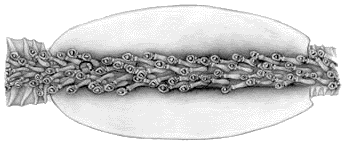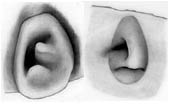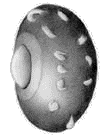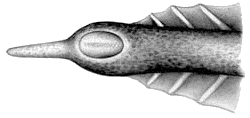- Arms
- Arms I 60% of ML
- Arms III 125% of ML
- Arms IV 200% 0f ML
- Largest with ca. 25 sharply pointed teeth. Teeth triangular distally becoming saw-toothed laterally; proximal 1/5 of sucker ring smooth.
- Largest suckers not globular.
- Tentacular clubs
- Club length 65% of ML
- Club suckers with 8 large, elongate, pointed teeth over distal 3/5 of ring; no enlarged central tooth.
- Sucker stalks in two distinct parts; each basal portion with small flag; stalks of lateral and medial suckers about equal in length.
- Protective membranes
- Membranes in three distinctive sets with intermediate set broadest.
- Proximal set with 32 slender, separate trabeculae (about 30% of club length).
- Intermediate set without distinct trabeculae (forms fleshy membrane) but opposite 13 rows of suckers (about 25-30% of CL).
- Distal set with slender separate, trabeculae opposite 31 rows of suckers (about 40-45% of CL).
 Click on an image to view larger version & data in a new window
Click on an image to view larger version & data in a new window
Figure. Oral view of club sucker and stalk of Chiroteuthis sp. B2. Note division of stalk and lack of pleats. Drawing by J. R. Schroeder.
Scanning electron micrographs of the arm and club suckers can be found here
- Head
- Head length 40% of ML.
- Head length 40% of ML.
- Funnel
- Funnel-locking apparatus with broad, protruding antitragus and hook-like tragus.
- Fins
- Fin length 40-45% of ML; fin width 40-45% of ML.
- Fin length 40-45% of ML; fin width 40-45% of ML.
- Photophores
- Eyeball - Two series of circular organs: lateral series (6 organs) = 1+4+1; medial series (5 or 6 organs) = 1+(3)4+1; terminal organs slightly larger than central organs.
- Viscera: two, large photophores.
- Club-tip photophore small, with long papilla.
- One embedded photophore on aboral surface of club opposite trabecula number 9 from proximal end of club.
- Pigmentation
- Club-tip photophore with chromatophore organs only (i.e., epithelial pigmentation absent).
- Club pigmentation in epithelial cells rather than chromatophore organs except at distal tip.
- Sucker stalks with light pigmentation, becoming less pigmented distally; without pleats.
- Buccal membrane unpigmented.
- Olfactory organ with chromatophores on stalk only.
- Silvery tissue on oral surface beneath epidermal pigmentation.
Chiroteuthis sp. B2 Description
Richard E. Young and Clyde F. E. RoperAbout This Page

University of Hawaii, Honolulu, HI, USA

Smithsonian Institution, Washington, D. C., USA
Page copyright © 1999 and
 Page: Tree of Life
Chiroteuthis sp. B2 Description
Authored by
Richard E. Young and Clyde F. E. Roper.
The TEXT of this page is licensed under the
Creative Commons Attribution-NonCommercial License - Version 3.0. Note that images and other media
featured on this page are each governed by their own license, and they may or may not be available
for reuse. Click on an image or a media link to access the media data window, which provides the
relevant licensing information. For the general terms and conditions of ToL material reuse and
redistribution, please see the Tree of Life Copyright
Policies.
Page: Tree of Life
Chiroteuthis sp. B2 Description
Authored by
Richard E. Young and Clyde F. E. Roper.
The TEXT of this page is licensed under the
Creative Commons Attribution-NonCommercial License - Version 3.0. Note that images and other media
featured on this page are each governed by their own license, and they may or may not be available
for reuse. Click on an image or a media link to access the media data window, which provides the
relevant licensing information. For the general terms and conditions of ToL material reuse and
redistribution, please see the Tree of Life Copyright
Policies.






 Go to quick links
Go to quick search
Go to navigation for this section of the ToL site
Go to detailed links for the ToL site
Go to quick links
Go to quick search
Go to navigation for this section of the ToL site
Go to detailed links for the ToL site